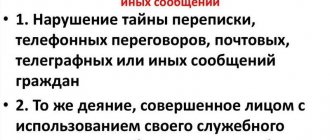Commentary on the article Judicial practice Comments (as amended by Federal Law dated November 4, 2014 N 332-FZ)
1. Propaganda or public display of Nazi paraphernalia or symbols, or paraphernalia or symbols that are confusingly similar to Nazi paraphernalia or symbols, or paraphernalia or symbols of extremist organizations, or other paraphernalia or symbols, the propaganda or public display of which is prohibited by federal laws, -
shall entail the imposition of an administrative fine on citizens in the amount of one thousand to two thousand rubles with confiscation of the subject of the administrative offense, or administrative arrest for a term of up to fifteen days with confiscation of the subject of the administrative offense; for officials - from one thousand to four thousand rubles with confiscation of the subject of the administrative offense; for legal entities - from ten thousand to fifty thousand rubles with confiscation of the subject of the administrative offense.
2. Production or sale for the purposes of propaganda or acquisition for the purpose of sale or propaganda of Nazi paraphernalia or symbols, or paraphernalia or symbols that are confusingly similar to Nazi paraphernalia or symbols, or paraphernalia or symbols of extremist organizations, or other paraphernalia or symbols, propaganda or public demonstration of which is prohibited by federal laws -
shall entail the imposition of an administrative fine on citizens in the amount of one thousand to two thousand five hundred rubles with confiscation of the subject of the administrative offense; for officials - from two thousand to five thousand rubles with confiscation of the subject of the administrative offense; for legal entities - from twenty thousand to one hundred thousand rubles with confiscation of the subject of the administrative offense.
Commentary to Art. 20.3 Code of Administrative Offenses of the Russian Federation
1. According to the Moscow Law “On administrative responsibility for the production, distribution and display of Nazi symbols on the territory of the city of Moscow” dated January 15, 1997 N 1 (as amended by the Moscow Law dated October 24, 2001 N 55):
Nazi symbols mean banners, badges, uniform attributes, greetings and passwords, which represent a reproduction in any form of the corresponding symbols used by the National Socialist Workers' Party of Germany and the Fascist Party of Italy: swastikas and other distinctive signs of state, military and other structures recognized as criminal Nuremberg International Tribunal, fasces, welcoming gestures, etc., as well as any other symbols and paraphernalia reminiscent of Nazi (fascist);
the production of Nazi symbols means the creation and reproduction of objects depicting the corresponding signs (symbols), or materials containing them: posters, leaflets, printed, photo, film and video products, etc.;
the distribution of Nazi symbols means the transfer of the above items or materials to other persons through sale or free distribution;
demonstration of Nazi symbols means its public display, display, wearing, hanging, depiction, reproduction on the pages of printed publications or in photo, film and video materials, replication and other actions that make its perception accessible;
Wearing Nazi symbols means the presence of symbols and paraphernalia reminiscent of Nazi (fascist) on clothing in the form of stripes, armbands, badges, and other elements, as well as wearing other items with its image (watches, bracelets, etc.).
Within the meaning of Art. 3 of the said Moscow Law, the reproduction of Nazi (fascist) symbols in the framework of feature or scientific films and publications condemning fascism or setting out historical events, as well as displaying religious rites and traditions using signs of the national heraldic symbols of Russia and others is not considered as an unlawful act countries when the corresponding symbols cannot be considered Nazi (fascist).
2. According to paragraphs 2 - 3 of Art. 1 of the Federal Law of July 25, 2002 N 114-FZ “On Combating Extremist Activities” propaganda and public display of Nazi paraphernalia or symbols or paraphernalia or symbols that are confusingly similar to Nazi paraphernalia or symbols; public calls for the implementation of the specified activities or the commission of the specified actions constitute a type of extremist activity (extremism).
The concept of “fascism” is not legally defined; In scientific literature, fascism, as a rule, is understood as a political movement based on the state ideology of a strong personality, leaderism, and racial superiority.
A state based on the ideology of fascism (Italian fascismo) was created in Italy in 1923 and lasted until April 27, 1945 (after the official capitulation of Italy on September 3, 1943, the successor to fascist statehood was the Italian Socialist Republic (Repubblica Sociale Italiana, RSI), proclaimed on September 18, 1943). Within the meaning of the commented article, fascist attributes or symbols also mean the attributes and symbols of Nazi Germany 1933 - 1945. In this case, it is necessary to take into account the objective ideological differences between the doctrines of Italian fascism and National Socialism, which exclude the identification of the concepts of “fascism” and “National Socialism” in their legal interpretation.
Within the meaning of this article, Nazi (fascist) paraphernalia refers to the essential distinctive features characteristic of fascist ideology and the fascist state.
In the commented article, Nazi (fascist) symbols are understood as a set of fascist symbols, among them state symbols: the state flag and the national anthem of fascist Italy and Nazi Germany, the military symbols of the SS troops, especially the military insignia of SS units, usually staffed by members of the National Socialist Workers' Party of Germany (NSDAP), volunteers - adherents of the ideology of National Socialism.
Nazi (fascist) symbols include:
- NSDAP emblem, banner (flags, standards), letterhead, posters, leaflets of the NSDAP and related symbols (jackets, caps, sleeve insignia, buckles, other parts of the equipment of NSDAP leaders), emblem and standards of the SA (Sturmabteilung, SA) - assault troops, paramilitary units of the NSDAP;
- emblem, flags, standards and other symbols of the fascist organization of former veterans of the national war - “Union of Veterans” (Fasci di Combattimento), National Fascist Party of Italy (Partito Nazionale Fascista), Fascist Republican Party of Italy (Partito Fascista Republicano);
— symbols of the SS (Schutzstaffeln, SS) (sleeve insignia, emblems, etc.), security paramilitary units of the NSDAP, including symbols of SS military units directly involved in hostilities (caps, field caps, sleeve patches, buttonholes, daggers , other details of the uniform), as well as symbols of the structural units of the SS, for example, insignia of the SD security service (Sicherheitsdienst, SD);
- symbols of the Gestapo (Geheime Staatspolizei, Gestapo) - the secret state police (emblem, badges of Gestapo employees, etc.).
Affiliation of the symbols of the Reichswehr, Wehrmacht (the name of the German armed forces in 1933 - 1934, 1935 - 1945, respectively), branches of the armed forces - Air Force, Navy, Ground Forces, operational control bodies of the German Armed Forces - the High Command of the Armed Forces (Oberkommando der Wehrmacht, OKW ); the main command of the ground forces (Oberkommando der Heeres, OKH); General Staff, Air Force Operations Command Headquarters (Oberkommando der Luftwaffe, OKL); Naval Headquarters (Oberkommando der Kriegsmarine, OKM); insignia of reservists, veterans and paramilitary organizations (Association of Veterans of the First World War (Kuffhauserbund), National Socialist German Union of Front-War Soldiers (First World War, NSDFB), Auxiliary Rural Police (Landwacht), Municipal Police (Gemeindepolizei), Security Police (Schutzpolitzei) , fire department (police, Feuerschutzpolizei), secret field police (Geheime Feldpolizei) - armbands, cockades, badges, neck plates, etc., as well as symbols of the Hitler Youth (Hitlerjugend) - a youth organization operating under the control of the NSDAP, breastplates ( qualification) signs certifying membership in the Hitler Youth, emblems, armbands (bandages), knives of members of the Hitler Youth, etc., are fascist symbols, in any case, disputable: in accordance with the decisions of the International Military Tribunal in Nuremberg, they were classified as criminal organizations leadership of the NSDAP, SS, SD and Gestapo.
In relation to the Federal Law of July 11, 2001 N 95-FZ “On Political Parties”, the emblem of a political party is considered as one of its symbols.
Dissemination or propaganda of attributes or symbols identified with Nazism (fascism) in electronic, print media or other forms with the aim of expanding their impact on various segments of the population is qualified as a considered administrative offense.
In accordance with paragraph 4 of Art. 1 of the Federal Law “On Combating Extremist Activities”, extremist materials are understood as documents or information on other media intended for publication, calling for the implementation of extremist activities or justifying or justifying the need for such activities, including the works of the leaders of the National Socialist Workers' Party of Germany, the fascist parties of Italy, publications that substantiate or justify national and (or) racial superiority or justify the practice of committing military or other crimes aimed at the complete or partial destruction of any ethnic, social, racial, national or religious group.
According to Art. 8 of the said Federal Law, in the event of dissemination of extremist materials through a mass media or identification of facts indicating the presence of signs of extremism in its activities, the founder and (or) editorial board (editor-in-chief) of this mass media by the authorized state body that registered this mass media , either the Ministry of Trade and Industry of Russia, or the Prosecutor General of the Russian Federation or the relevant prosecutor subordinate to him, issues a warning in writing about the inadmissibility of such actions or such activities, indicating the specific grounds for issuing the warning, including violations committed. If it is possible to take measures to eliminate the violations committed, the warning also sets a period for eliminating these violations, which is at least 10 days from the date of the warning.
The warning may be appealed to the court in accordance with the established procedure.
If the warning was not appealed to the court in the prescribed manner or was not recognized by the court as illegal, and also if, within the period established in the warning, measures were not taken to eliminate the violations that served as the basis for issuing the warning, or if again within 12 months from the date After issuing a warning, new facts have been identified indicating the presence of signs of extremism in the activities of the mass media, the activities of the relevant mass media are subject to termination in the manner established by the specified Federal Law.
When interpreting this article of the Administrative Code, one should take into account various translation options for the name of the Nazi Party of Germany (Nazionalsozialistische Deutsche Arbeiterpartei) in relation to this Federal Law and the Moscow Law “On administrative responsibility for the production, distribution and display of Nazi symbols on the territory of the city of Moscow” (see definition Nazi symbols in paragraph 2 of this commentary). At the same time, the Federal Law “On Combating Extremist Activities,” in contrast to the Moscow Law, is based on the traditional version of the translation introduced into use by Soviet scientific literature (cf., for example, with the modern version of the translation of the NSDAP: Raevsky M.V. German- Russian dictionary of abbreviations. M., 2000. P. 192).
3. See note to paragraph 5 of the commentary to Art. 5.1.
Cases of administrative offenses provided for in the commented article are considered by magistrates (cf. part 1 of article 23.1 of the Administrative Code and paragraph 4 of part 3 of this article).
Legal educational program: responsibility for propaganda of Nazi symbols and extremism
The most important direction of the state policy of the Russian Federation to perpetuate the Victory of the Soviet people in the Great Patriotic War is a decisive fight against manifestations of fascism.
In the Russian Federation, the use of Nazi paraphernalia or symbols, or paraphernalia or symbols that are confusingly similar to Nazi paraphernalia or symbols, as insulting the multinational people and the memory of the victims suffered in the Great Patriotic War, is prohibited.
Federal Law “On the Perpetuation of the Victory of the Soviet People in the Great Patriotic War of 1941-1945” dated May 19, 1995 No. 80-FZ in Art. 1 of this Federal Law contains important provisions establishing the prohibition of fascism.
The study and condemnation of the system of Nazi law carried out at the Nuremberg trials were reflected in the definition of fascism given by the Russian Academy of Sciences (1995) (See Constitutional law of foreign countries / Edited by A.V. Malko. M.: Norma, 2004. P. 319).
Fascism (Nazism) is an ideology and practice that asserts the superiority and exclusivity of a particular nation or race and is aimed at inciting national intolerance; justification for discrimination against representatives of other peoples; denial of democracy, establishment of the cult of the leader; the use of terror violence to suppress political opponents and all forms of dissent; justification of war as a means of resolving international problems.
The Federal Law of July 25, 2002 No. 114-FZ “On Combating Extremist Activities” (hereinafter referred to as the Law on Combating Extremism) is devoted, in particular, to the regulatory regulation of the fight against such a phenomenon as extremism.
Article 1 of the Law contains a list of characteristics included in the concept of extremism. In particular, extremism (extremist activity) includes:
— violent change of the foundations of the constitutional system and violation of the integrity of the Russian Federation;
— public justification of terrorism and other terrorist activities;
— inciting social, racial, national or religious hatred;
- propaganda of exclusivity, superiority or inferiority of a person on the basis of his social, racial, national, religious or linguistic affiliation, or attitude to religion;
- use of Nazi paraphernalia or symbols, or paraphernalia or symbols confusingly similar to Nazi paraphernalia or symbols, or paraphernalia or symbols of extremist organizations, with the exception of cases of use of Nazi paraphernalia or symbols, or paraphernalia or symbols similar to Nazi paraphernalia or symbols to the extent of confusion the degree of confusion, or attributes or symbols of extremist organizations, in which a negative attitude towards the ideology of Nazism and extremism is formed and there are no signs of propaganda or justification of Nazi and extremist ideology;
- organization and preparation of these acts, as well as incitement to their implementation;
- financing of these acts or other assistance in their organization, preparation and implementation, including by providing educational, printing and material and technical base, telephone and other types of communication or provision of information services, etc.
The Criminal Code of the Russian Federation (hereinafter referred to as the Criminal Code of the Russian Federation) in note 2 of Art. 282.1 also defines this concept for the purposes of bringing to criminal liability for relevant crimes.
In particular, crimes of an extremist nature in the Russian Federation mean crimes committed on the grounds of political, ideological, racial, national or religious hatred or enmity, or on grounds of hatred or enmity against any social group, provided for by the relevant articles of the Special Part of the Criminal Code of the Russian Federation (for example , Article 280, 280.1, 282, 282.1, 282.2, 282.3 of the Criminal Code of the Russian Federation, paragraph “l” part 2 of article 105, paragraph “e” part 2 of article 111, paragraph “b” part. 1 Article 213 of the Criminal Code of the Russian Federation), as well as other crimes committed for the specified reasons, which in accordance with paragraph “e” of Part 1 of Art. 63 of the Criminal Code of the Russian Federation are recognized as an aggravating circumstance.
You should also pay attention to the act of judicial interpretation of Resolution of the Plenum of the Supreme Court of the Russian Federation dated June 28, 2011 N 11 “On judicial practice in criminal cases of crimes of an extremist nature,” where paragraph 2 provides the corresponding definition of crimes of an extremist nature.
Based on Art. 15 of the Law on Combating Extremism, for carrying out extremist activities, citizens of the Russian Federation, foreign citizens and stateless persons bear criminal, administrative and civil liability in the manner established by the legislation of the Russian Federation.
Yes, Art. 20.3 of the Code of Administrative Offenses of the Russian Federation provides for administrative liability for propaganda or public display of Nazi paraphernalia or symbols, or paraphernalia or symbols that are confusingly similar to Nazi paraphernalia or symbols, paraphernalia or symbols of Nazi, extremist organizations, as well as other paraphernalia or symbols prohibited by federal laws, and also for the production or sale for the purposes of propaganda or the acquisition for the purposes of sale or propaganda of the specified paraphernalia or symbols.
Article 20.29 of the Code of Administrative Offenses of the Russian Federation provides for administrative liability for the mass distribution of extremist materials included in the published federal list of extremist materials, as well as their production or storage for the purpose of mass distribution.
The Criminal Code of the Russian Federation, in particular, specifies the following elements of extremist crimes:
- public calls (i.e. appeals to other persons in any form) to carry out extremist activities (Article 280 of the Criminal Code of the Russian Federation, paragraph 4 of the Resolution of the Plenum of the Armed Forces of the Russian Federation on crimes of an extremist nature);
— public calls for actions aimed at violating the territorial integrity of the Russian Federation (Article 280.1 of the Criminal Code of the Russian Federation);
- actions (for example, statements about the need for illegal actions) aimed at inciting hatred or enmity, as well as humiliating the dignity of a person or group of persons on the basis of gender, race, nationality, language, origin, attitude to religion, as well as belonging to any or to a social group, committed publicly, including using the media or information and telecommunication networks, including the Internet, committed by a person after he was brought to administrative responsibility for a similar act within one year (Part 1 of Article 282 of the Criminal Code of the Russian Federation, clause 7 of the Resolution of the Plenum of the Armed Forces of the Russian Federation on crimes of an extremist nature);
As stated in paragraph. 2 clause 2.1 of the Resolution of the Plenum of the Armed Forces of the Russian Federation on crimes of an extremist nature, taking into account the content of the disposition of Art. 282 of the Criminal Code of the Russian Federation, data indicating signs of relevant crimes includes not only the fact of posting on the Internet or other information and telecommunications network an image, audio or video file containing signs of inciting hostility and hatred, humiliation of the dignity of a person or group of persons on grounds contained in this article, but also other information indicating the social danger of the act and the motive for its commission.
According to para. 2 clause 8 of the Resolution of the Plenum of the Armed Forces of the Russian Federation on crimes of an extremist nature, posting by a person on the Internet or other information and telecommunications network, in particular, on one’s own page or on the pages of other users of material (for example, video, audio, graphic or text), created by himself or another person, including information previously recognized by the court as extremist material, can be qualified under Art. 282 of the Criminal Code of the Russian Federation only in cases where it is established that the person who posted such material was aware of the intent of the act to violate the foundations of the constitutional order, and also had the goal of inciting hatred or enmity or humiliating the dignity of a person or group of persons on the basis of gender, race, nationality, language , origin, attitude to religion or membership in any social group.
- creation of an extremist community, management of such a community, its part or structural units included in such a community, creation of an association of organizers, leaders or other representatives of parts or structural units of such a community in order to develop plans and (or) conditions for committing extremist crimes, participation in it, inducement, recruitment and other involvement of persons to participate in it (Article 282.1 of the Criminal Code of the Russian Federation);
- organizing the activities of an extremist organization (a public or religious association or other organization in respect of which the court has made a decision to liquidate or prohibit activities that have entered into legal force in connection with the implementation of extremist activities), inducing, recruiting or otherwise involving a person in the activities of an extremist organization, and also participation in its activities (Article 282.2 of the Criminal Code of the Russian Federation);
— financing of extremist activities (Article 282.3 of the Criminal Code of the Russian Federation).
You should also pay attention to the fact that on the basis of paragraph “e” of Part 1 of Art. 63 of the Criminal Code of the Russian Federation, the commission of a crime based on political, ideological, racial, national or religious hatred or enmity, or based on hatred or enmity against any social group is recognized as an aggravating circumstance.
N.V. Kislitsyna, assistant city prosecutor, 1st class lawyer
Source:
https://involokolamsk.ru/novosti/zakon-i-poryadok/vashe-pravo/pravovoy-likbez-otvetstvennost-za-propagandu-nacistskoy-simvoliki-i-ekstremizm



